Affiliates note: As an Amazon Associate I earn from qualifying purchases. My content may contain affiliate links to products and services. If you click through and make a purchase, I'll receive a small commission. It does not affect the price you pay.
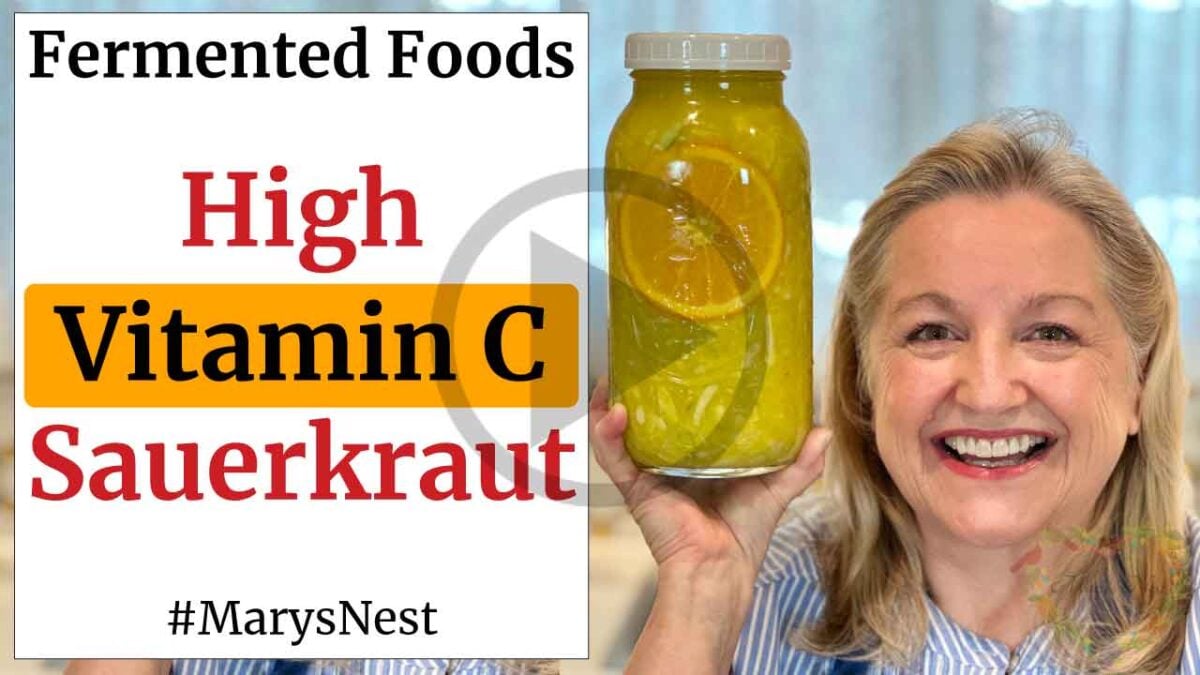
Learn how to make sauerkraut with oranges for a vitamin C boost! Cabbage contains vitamin C, and when you ferment it, the vitamin C increases exponentially and becomes easier for us to digest and absorb.
Next, by adding fresh oranges to our fermenting cabbage, we give our sauerkraut an added boost of vitamin C, making this recipe the perfect fermented food to increase the good bacteria in our digestive system and gain all the benefits of this helpful vitamin.
How to Make Sauerkraut with Oranges
If you’re new to making ferments, it’s easy to make sauerkraut with oranges because it is similar to making regular sauerkraut. At a high level, all you need to do is:
- Shred some cabbage.
- Mix it with salt.
- Add a purée of oranges.
- Pack everything into a clean jar.
- Let the mixture ferment for a few days at room temperature.
My recipe provides you with the complete list of ingredients and step-by-step instructions, and I also include a special ingredient that gives you an insurance policy for a successful ferment!
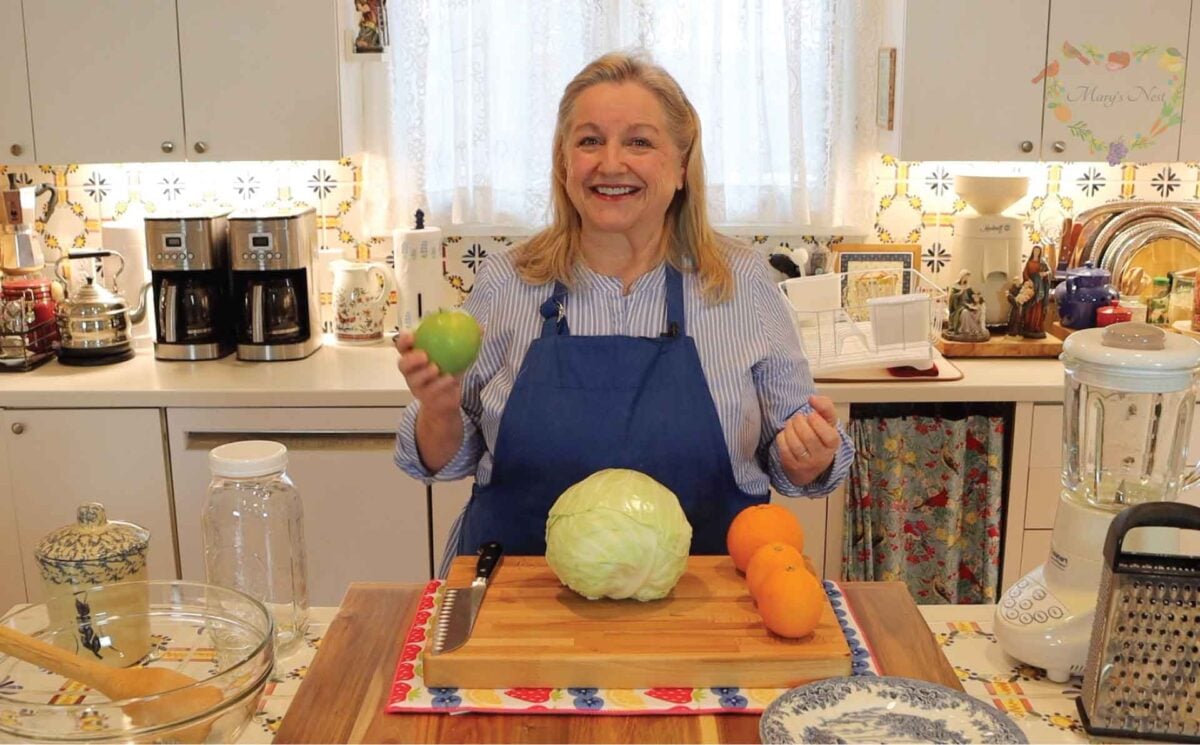
How to Make Sauerkraut with a Secret Ingredient
As I have shared with you in the past, ferments can be persnickety, especially vegetable ferments! So you want to do everything you can to ensure your ferment will be successful. That is where my secret ingredient—or insurance policy—comes in. And what is this ingredient? Something I am confident that you have on hand. It’s an apple! It doesn’t matter what type of apple it is. Any apple will do.
Apples contain pectin, which is considered a pre-biotic. Good bacteria—or pro-biotics—love to eat the prebiotic pectin. So by giving the good bacteria what it likes to eat, the better the chances are that they will proliferate and overtake the potential development of bad bacteria. Once the good bacteria get a strong foothold in your ferment, you are on the road to success!
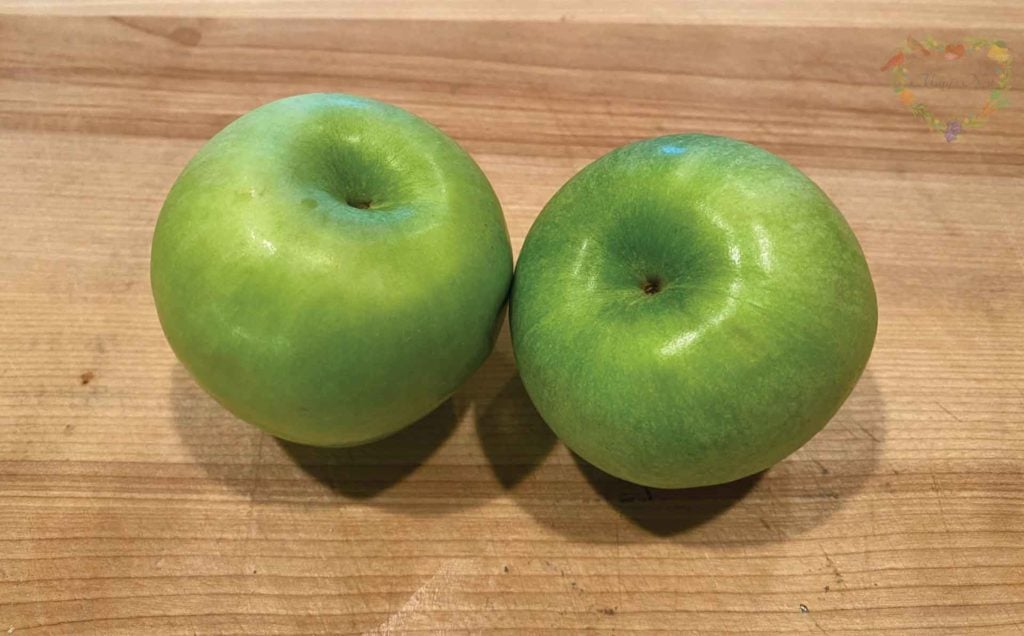
Making Sauerkraut with an Apple Adds Extra Benefits
Adding an apple to your grated cabbage when making sauerkraut adds an extra benefit. Yes, it provides food for the good bacteria to munch on, but the apple skin also provides food for an exceptional good bacteria known as a super probiotic.
This super probiotic is Akkermansia Muciniphila, which is a powerful bacteria that can help with the following:
- Weight Control
- Blood Sugar
- Gut Barrier Strength
To learn more about this amazing probiotic and how to make a whole host of cultured foods, visit the Cultured Food Life website. You can also read two helpful books on the subject by Donna Schwenk:
And for an even more in-depth exploration into fermented foods, be sure to read both of Sander Katz’s books on the subject. Sandor is considered the “father” of the modern-day fermentation movement, and his books are invaluable resources.
Use Real Salt for a Successful Ferment
When it comes to making vegetable ferments, it’s important to use plain salt. You do not want salt that contains any chemicals often labeled in the ingredients as anti-caking agents. These additives will only serve to interfere with the fermentation process.
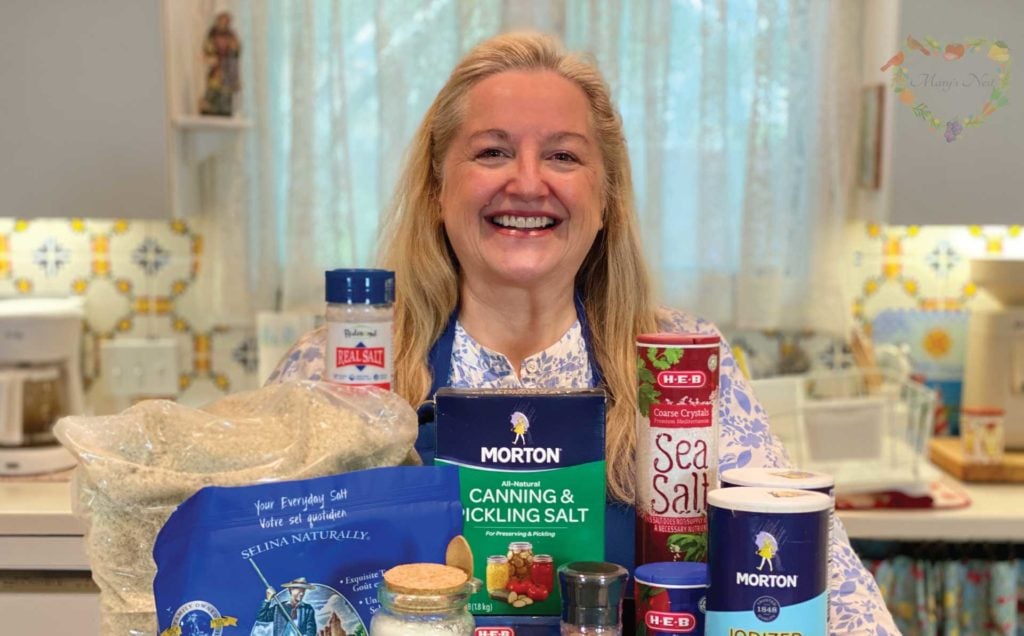
When making ferments, including sauerkraut with oranges, we want to do everything in our power to be successful. And using a simple plain salt will provide us with the best result. These plain salts include options like Celtic grey salt and Redmond Real Salt.
In the following video, I show you the essential salts to stock in your Prepper Pantry and use in your ferments with the least microplastics.
Try Redmond Real Salt with a 15% Discount
When it comes to using salt in my recipes, I always like to use a real salt that has not been processed and does not contain any extra added chemicals or anti-caking agents. Redmond real salt is perfect! And if you’d like to order Redmond Real Salt from their website, be sure to check out my Shopping Guide for a discount coupon code.
- Redmond Real Life – For Real Salt and other products, use this link and discount code MARYSNEST for 15% off your purchase. (Discount will show at checkout.)
My Ferment is Too Salty
In the following video, I also answer a common question that I receive from many viewers about fermentation: Why does my ferment taste so salty? I’ll explain why and what you can do.
What is Kahm Yeast?
If you are new to making ferments and you happen to encounter Kahm yeast at the top of your ferment, you might be worried that it’s mold and that your ferment is ruined. Take heart! Chances are, if it looks like a spider web and it’s not fuzzy (like mold tends to be), your ferment is fine.
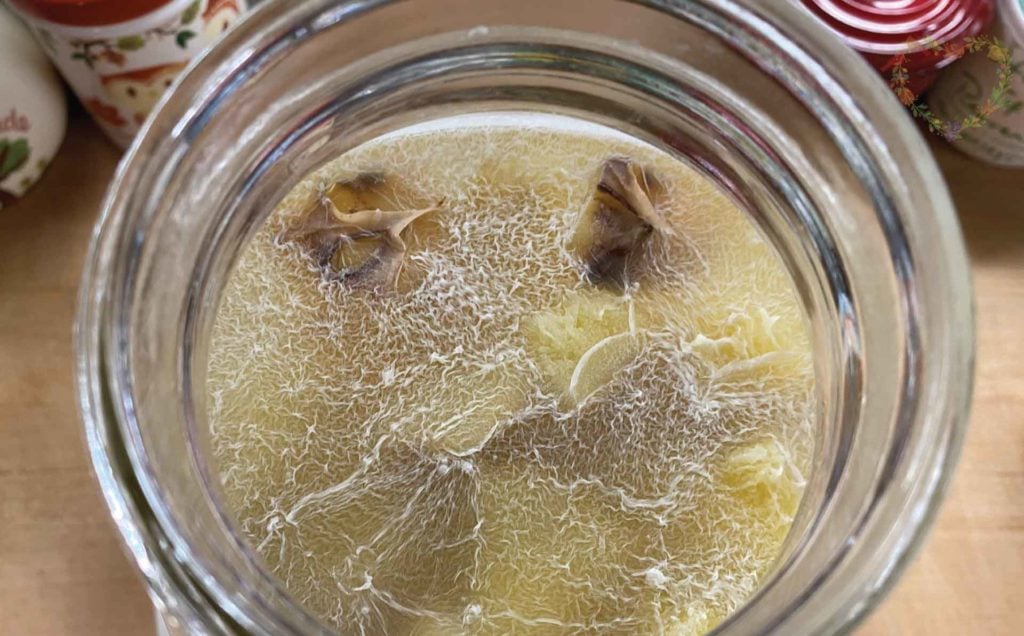
Simply use a clean spoon to remove the layer of Kahm yeast and allow your ferment to continue on its fermentation journey. The Kahm yeast may return, but just spoon it off once again and carry on. Once your ferment is refrigerated, the Kahm yeast should no longer be a problem.
You can learn more about Kahm yeast and other scary traditional foods in the following blog post.
Save Those Scraps
If you have orange peels, save them to make homemade digestive bitters, or if you have apple scraps, save them to make apple cider vinegar. (And vegetable scraps always come in handy for making bone broth. I like to save my vegetable scrap bag for bone broth in a plastic bag that I store in a plastic container in my freezer.)
A Delicious Golden Sauerkraut Recipe
Are you looking for more sauerkraut recipes? Many of you know my sweet friend Michele over at Chocolate Box Cottage. Well, you are in for a real treat because Michele shares her delicious Golden Sauerkraut recipe with a video and recipe on her website.
And while you are over there, spend some time looking through Michele’s “Recipe Box,” where she shares a whole host of traditional recipes, including a recipe for fluffy homemade egg noodles passed down to her from her grandmother.
More Recipes with Cabbage
If you’re looking for a simple sauerkraut, traditional red cabbage, or a fried cabbage recipe, I’ve got you covered. Watch the videos below, where I provide step-by-step instructions for making each recipe. (And the homemade sauerkraut video has over 2.5 million views on YouTube!)
Masontops Mason Jar Fermentation Kit Discount Coupon
Although you don’t need any special equipment to start making ferments, the Masontops kit can help you simplify the process and enable you to create your ferment successfully. In my Masontops unboxing video, I show you my Masontops Complete Mason Jar Fermentation Kit and go over everything the kit includes.
- Use promo code MARYSNST for a one-time 15% off Masontops and Breadsmart products on Amazon.com. (This is not a sponsored post. Masontops provided me with a special discount code for my viewers. I like their products, and I think you will too.)
Download Your Free 36-Page Pantry List
For an extensive list of the traditional foods you can make and purchase to stock your pantry, be sure to download my free 36-page Traditional Foods Pantry List. This comprehensive eBook is full of links to recipe videos, helpful articles, and more!
Kitchen Academy Videos
Are you looking for more traditional foods videos? If so, I invite you to join the Traditional Foods Kitchen Academy. Members of this optional paid YouTube community get access to exclusive videos, live streams, and other members-only perks. Plus, your YouTube comments include a special members-only badge.
In the following replay of my members-only live stream, I talk about cultured dairy, among other traditional food topics.
Stay in Touch with Mary’s Nest
- Subscribe to My YouTube Channel for Traditional Foods Videos (Free) - When you subscribe, be sure to click on the notification bell that will let you know each time I upload a new video.
- Subscribe to Mary’s Traditional Foods Newsletter (Free) - Get a free 36-page eBook for signing up: How to Stock Your Essential Traditional Foods Four-Corners Pantry.
- Join the Traditional Foods Kitchen Academy - For more detailed videos and exclusive members-only perks, join my YouTube membership community.
- Order The Modern Pioneer Cookbook - Get a hardcover book of Mary's nourishing recipes from a Traditional Foods Kitchen. This bestselling cookbook is published by Penguin Random House with their DK imprint.
- Preorder The Modern Pioneer Pantry - Be one of the first to get Mary's hardcover book about preserving food and making delicious meals from your Four Corners Pantry. Mary's second cookbook is also published by Penguin Random House.
I look forward to having you join me in my Texas Hill Country Kitchen!
I’d like to receive more tips and recipes from Mary’s Nest.
Sauerkraut with Oranges
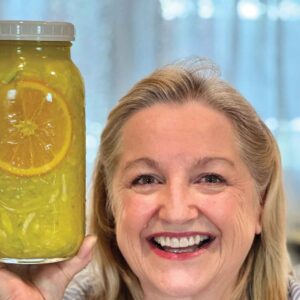
Equipment
- 1 Half-gallon glass jar (64 ounces) with lids Alternatively, 2 quart-size glass jars with lids
- 1 Four-ounce glass jar ("jelly jar") Alternatively, 2 Four-ounce glass jars
- 1 Large bowl
- 1 Kraut pounder Alternatively, you can use a potato masher, wooden spoon, or clean hands
- 1 Microplane grater optional
- 1 Electric blender Alternatively, you can use a manual box grater.
- 1 Bowl that can hold the half-gallon jar in an upright position
Ingredients
- 3 lb Head of green cabbage You can substitute other cabbages, such as Savoy.
- 1 1/2 tbsp Fine ground sea salt You can substitute two rounded tablespoons of coarse ground sea salt.
- 2 large Oranges, any variety
- 1 large Apple, any variety
- Chlorine-free water, if needed
Instructions
- Remove the first layer of cabbage leaves from the head of cabbage and set aside.
- Slice the head of cabbage in half and cut out the core. Set the core aside but do not discard it.
- Slice the cabbage into fine shreds. Add the shredded cabbage to a large bowl and sprinkle with salt.
- Pound the cabbage for 1-2 minutes using a kraut pounder until the cabbage begins to soften slightly. Alternatively, if you do not have a kraut pounder, you can use a potato masher, the back of a large spoon, or your clean hands. Set the cabbage aside.
- Slice one orange in half across its diameter. Once sliced in half, cut two thin slices from one half. Set the two slices aside.
- Zest each orange half and the remaining whole orange and add the zest to the bowl with the cabbage.
- Peel the pith away from the flesh of the orange, rough chop the flesh, and add it to the blender. Alternatively, if you want to include the pith, do not peel the oranges. Instead, just chop them up and add them to the blender.
- Quarter the apple and remove the core. Rough chop the apple quarters and add them to the blender.
- Rough chop the core of the cabbage and add it to the blender.
- Put the lid on the blender and blend the oranges, apple, and cabbage core together to create a slurry (purée). This may take a few minutes, and you may have to stop the blender periodically and scrape down the sides. You may also need to add a 1/4 cup or more of water to help the fruit to blend completely.
- Once the oranges, apple, and cabbage core are completely puréed, pour the slurry on top of the cabbage and mix well. Using the kraut pounder, pound the mixture for a few minutes until the cabbage is quite soft and has released much of it's moisture.
- Cook's Note: If you do not have a blender, you can grate the oranges, the apple, and the core of the cabbage and then add them to the shredded cabbage.
- Begin transferring the cabbage mixture to the half-gallon jar using a clean spoon. After each spoonful, use the kraut pounder to compress the cabbage down into the jar as tightly as possible.
- When the jar is half full, slide the orange slices down opposite sides of the jar and then continue to fill the jar with the remaining cabbage pressing down on the cabbage mixture after each spoonful.
- Fill the jar with the cabbage within 2 inches of the rim of the jar. Fold the reserved cabbage leaves and place them into the jar on top of the shredded cabbage.
- If you have any additional shredded cabbage that does not fit into the jar, place it into a smaller jar and allow it to ferment separately.
- Place the four-ounce jar on top of the folded cabbage leaves and press down firmly. Some liquid may rise to the rim of the jar and spill over into the smaller jar. This is normal. Place the lid on the jar and tighten it.
- Place the jar into a bowl in which it can stand safely without wobbling. (This bowl will catch any liquid that might seep out of the jar.)
- Place the jar in the bowl in an area that will maintain a temperature between 68°F to 72°F (20°C to 22°C).
- After a few days, you should notice that bubbles are beginning to form in the jar. These bubbles are the gas carbon dioxide and are a by-product of the fermentation process. Release the lid and allow the gas to escape. Retighten the lid. (This is known as burping the jar.)
- After 7 days, use a pH strip to determine the pH of the sauerkraut. To do this, use a clean spoon to remove some of the brine from the sauerkraut and place the pH strip in the removed brine. The strip will change color, and you will need to compare it to the pH scale on the strip packaging. (See video.) You want your ferment to have a pH of 4.6 or lower. This guarantees that bad bacteria can not proliferate in your ferment, and it is safe to eat.
- If the pH is above 4.6, allow the sauerkraut to continue to ferment for up to 14 days. If, after 14 days, the pH has not reached 4.6 or lower, I recommend that you discard the sauerkraut and start a new batch. If allowed to continue to ferment, there is the possibility of the development of bad bacteria, as well as a degradation in the texture of the sauerkraut. (See the Recipe Notes below.)
- With your sauerkraut at the right pH level, remove the lid from the jar of sauerkraut. Next, remove the small glass jar and set it aside, place the lid back on to the jar of sauerkraut, and refrigerate, preferably on the top shelf of your refrigerator or in the door of your refrigerator. Ferments are happiest when stored at approximately 40°F (4°C), so the warmest part of your refrigerator is the best place for your ferment.
- Allow the sauerkraut to "cure" in your refrigerator for two weeks, at which time the cabbage will absorb more of the salty brine and become tastier. The brine, which clings to the sauerkraut, will become less salty. It will now be ready to eat.
- Your sauerkraut with oranges will stay fresh in your refrigerator for six months but will be at its peak at two to three months.
Video
Notes
Shop for items used in this blog post or video
Favorite Fermentation Supplies
- Half Gallon Canning Jars
- 4-ounce Jelly Jars
- Storage Lids
- pH Strips
- Silicone Pickle Pipes
- Fermentation Glass Weights
- Wooden Pickle Packer
- Wooden Kraut Pounder
- Masontops Fermentation Kit
Use promo code MARYSNST for a one-time 15% off Masontops and Breadsmart products on Amazon.com.
Favorite Kitchen Supplies
- Favorite Aprons
- Spice Grinder
- Countertop Burner (On my kitchen island in many recipe videos.)
- Handheld Vacuum Sealing System
- Vacuum Lids
- Whisk
- Silica Gel Packets (Helps keep moisture from building up in your mix)
- Cast Iron Dutch Oven
- 8-Quart Slow-Cooker
- Fat Separator (Clever kitchen device to help you decant bone broth)
- Flour Sack Towels
- pH Strips (Helps you check on the acidity of your vinegar)
- Mockmill Grain Mill (for making homemade flour)
Learn more about Mockmill electric grain mills for making fresh flour and their Flake Lover's Flaker that flakes whole grain in minutes.
Amazon Shop and Shopping Guide
- Visit Mary’s Nest Amazon Shop
- Visit my Shopping Guide page
Get up to 15% off for stocking your Traditional Foods Pantry and equipping your Modern Pioneer Kitchen, including discounts from US Wellness Meats, Farmhouse Teas, Lehman's, Masontops, Cultures for Health, Survival Garden Seeds, Redmond Real Salt, Plan to Eat, and More!
Recommended Reading
- Cultured Food for Life: How to Make and Serve Delicious Probiotic Foods for Better Health and Wellness
- Cultured Food for Health: A Guide to Healing Yourself with Probiotic Foods
Disclaimer:I am not a medical doctor, a medical professional, a dietician, or a nutritionist. All content found on the MarysNest.com website, including text, images, videos, eBooks or eGuides, social media, or other formats, were created solely for informational purposes only. The content is not intended to be a substitute for professional medical advice, diagnosis, or treatment. Always seek the advice of your physician or other qualified healthcare provider with any questions you may have regarding a medical condition or proper nutritional advice. Never disregard professional medical advice or delay in seeking it because of something you have watched in a video or read on this website. Use caution when following the recipe in this video. The creator and publisher of this video and website will not be held responsible for any adverse effects that may arise from the use of this recipe and method or any other recipe and method on this website or corresponding video channel.

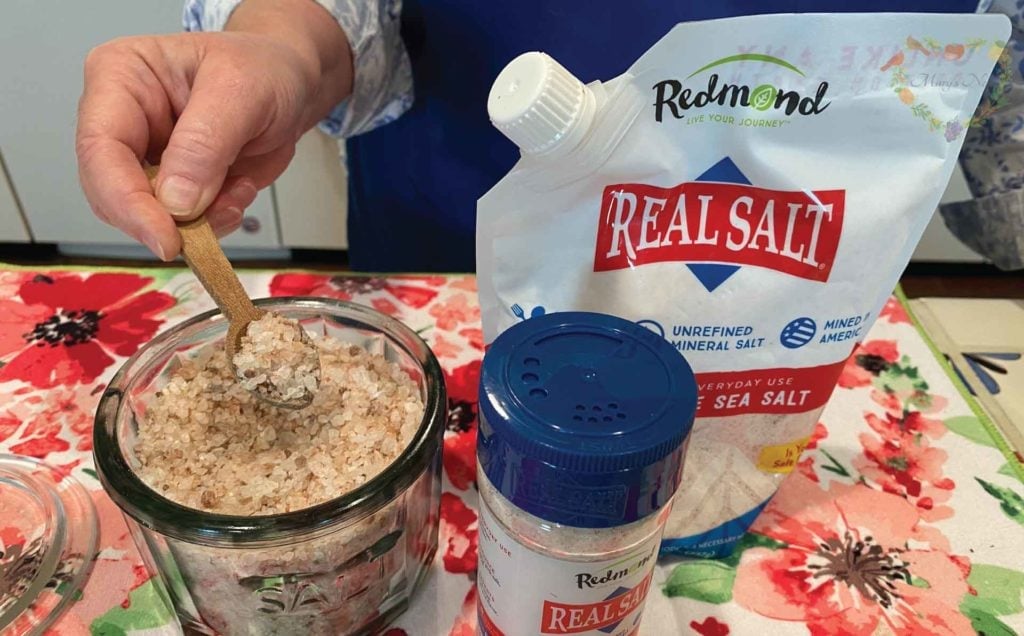
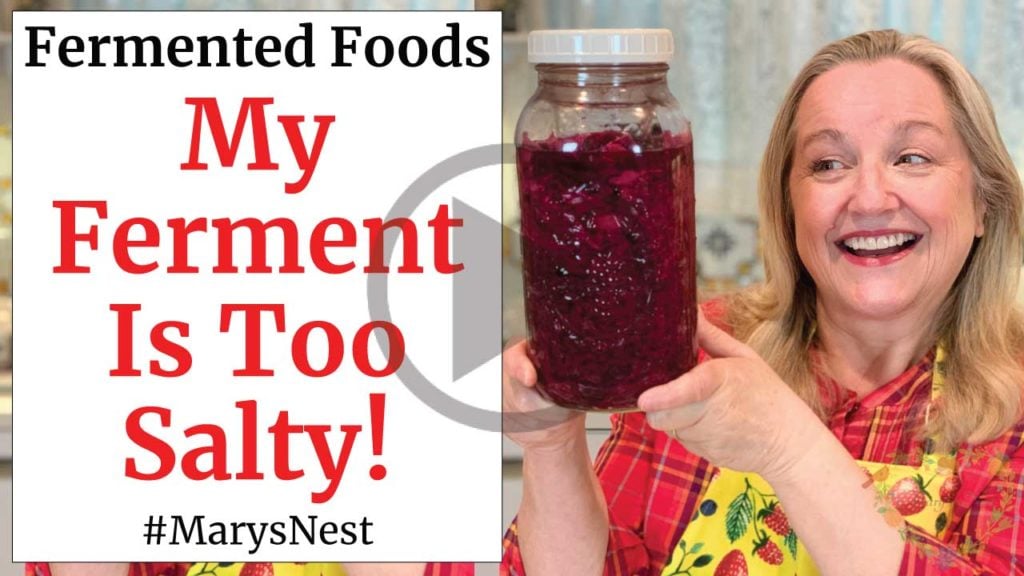
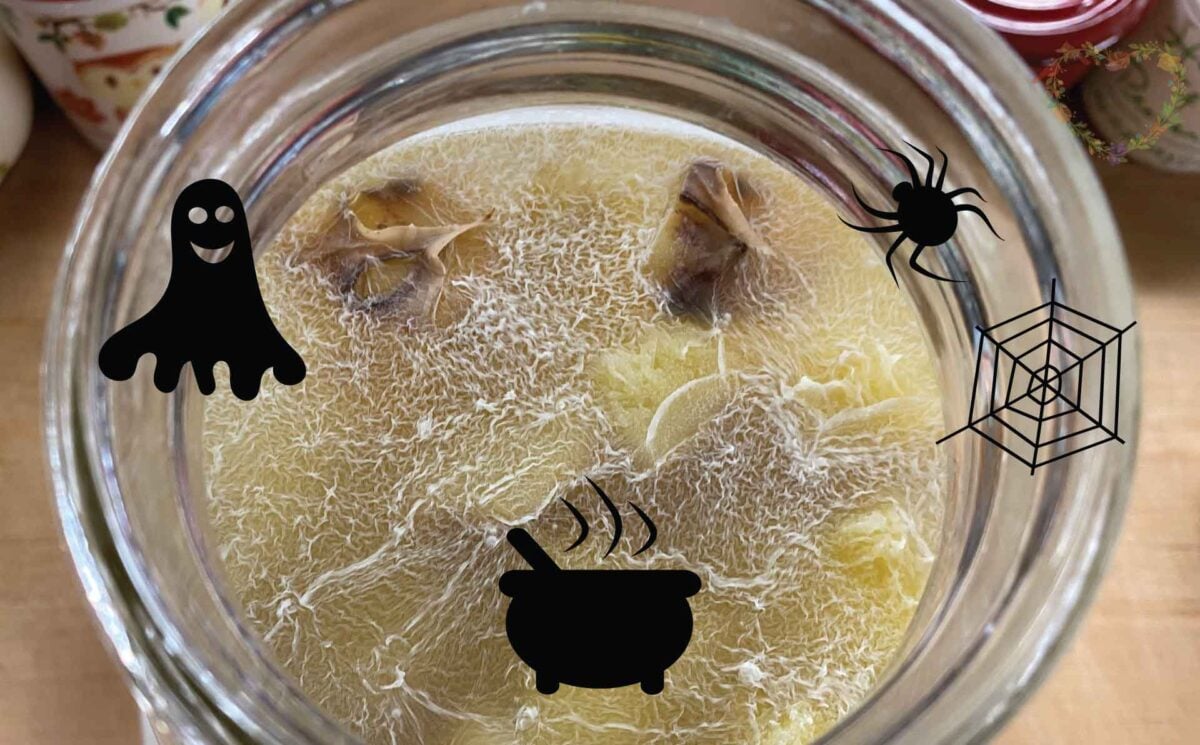
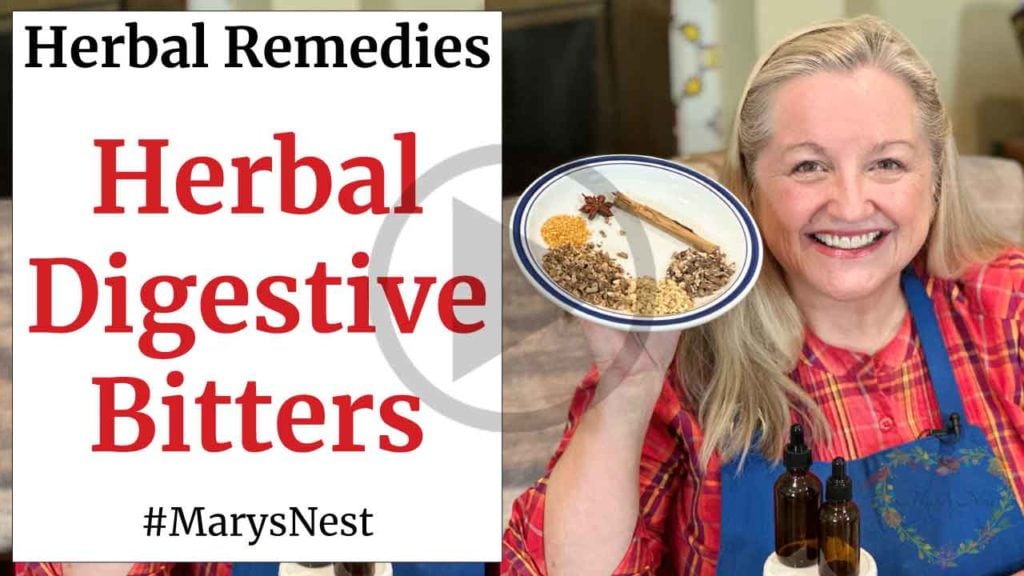
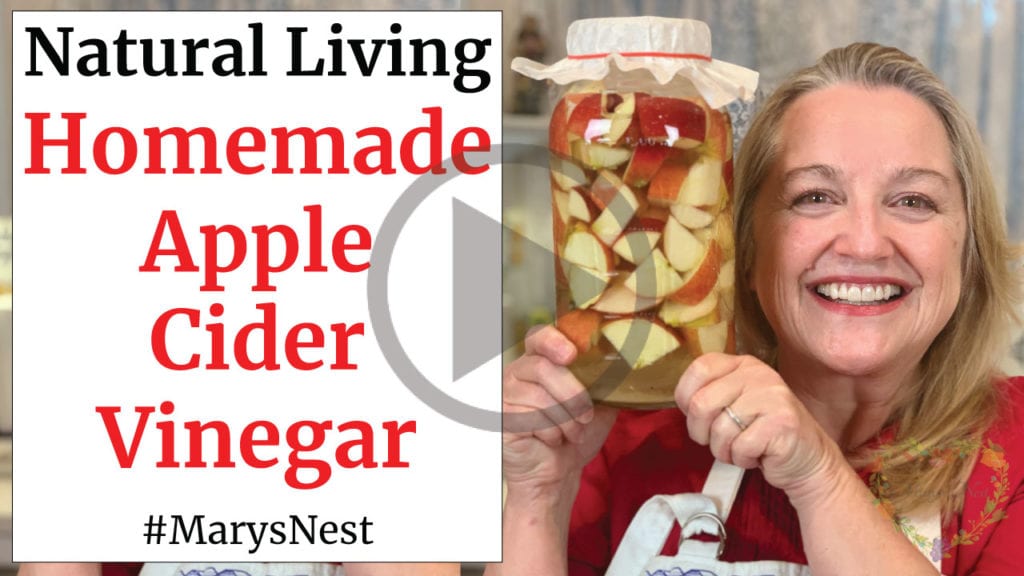
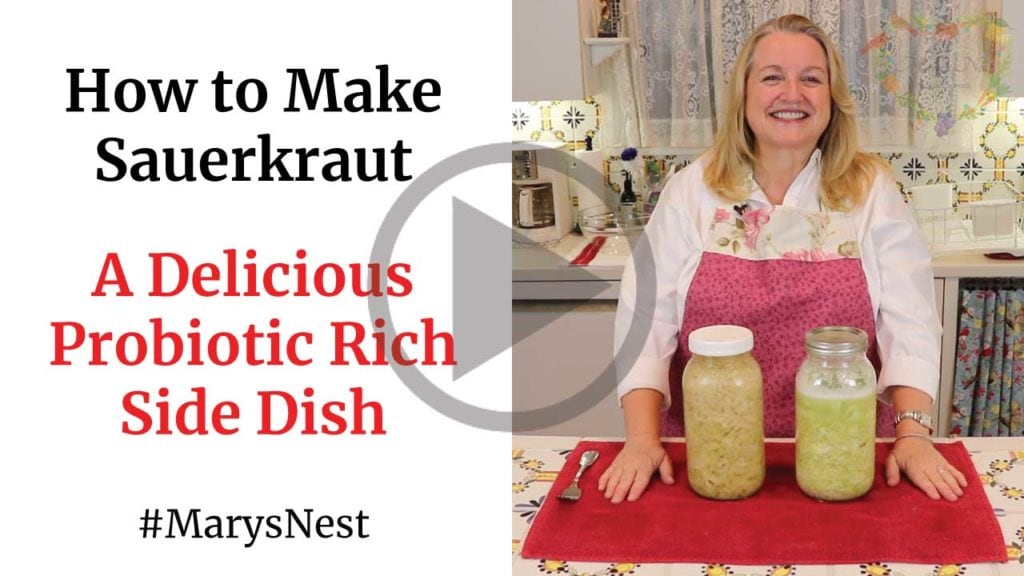
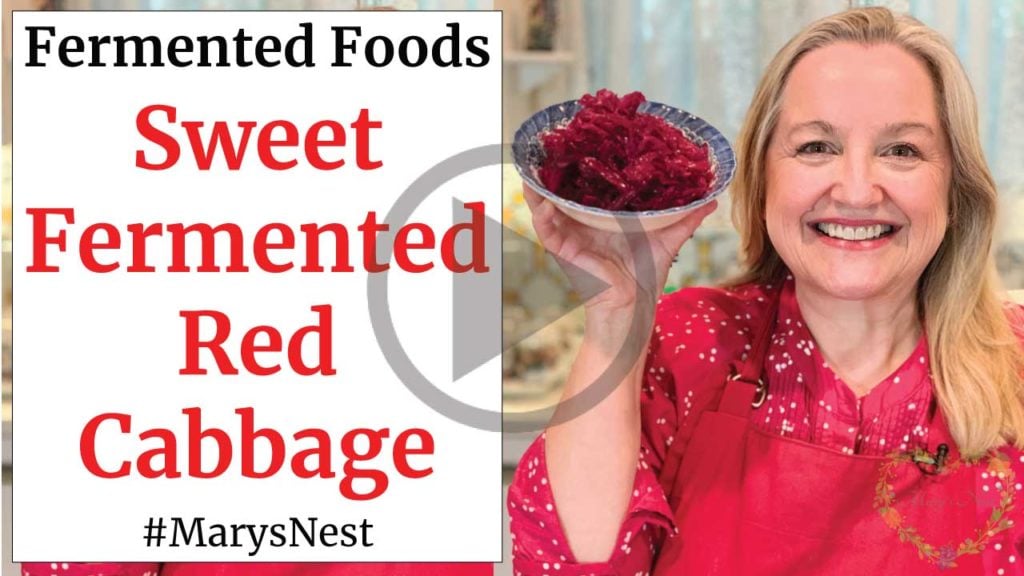
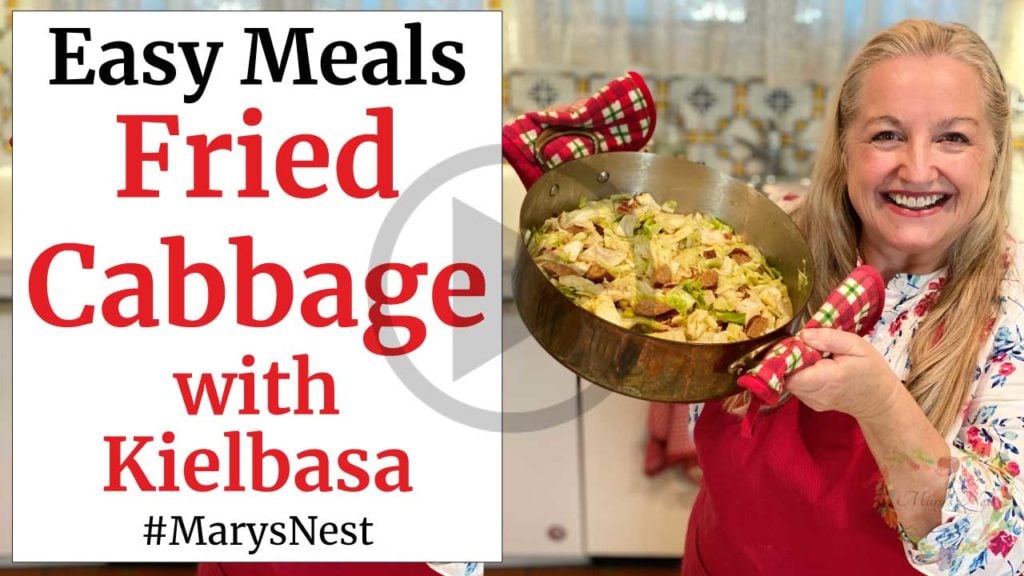
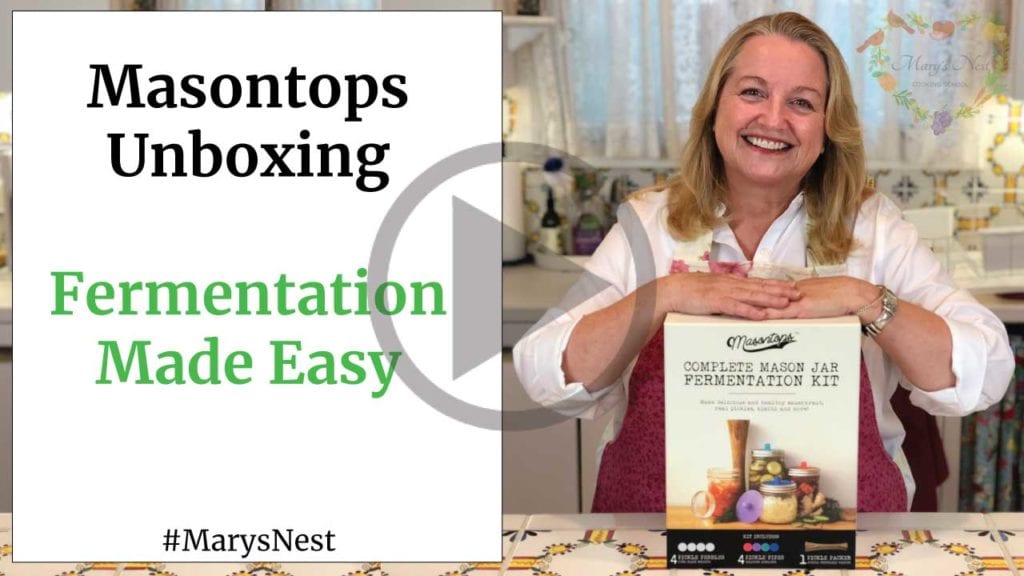



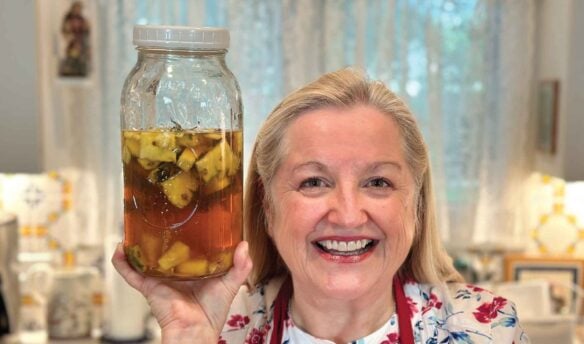

Mary, still learning, and thrilled. Lost nearly 100lbs accidently since I started all this for my grandsons chronic muscular skeletal pain. Which, BTW, as I’ve mentioned before, he’s no longer being treated for. AT ALL.
Your guidance was pivotal to how I was going to pull off the diet. I’d never heard of the term “traditional kitchen’ 2 years ago.
Along with your references and my diligence, I’ve not given up on sourdough, I will not concede victory!
But to anyone just starting, it’s possible, don’t give up and Mary’s best advice to me, do what you can, just do it.
Oh Lynn!! I am so happy to read this. And I am honored and humbled to be on this traditional foods journey with you!! Love, Mary
cultured food i have her older book yes been wanting more saurk lol and get more orages diane bolt x
st thomas ontario canada
Hi Diane, Yes indeed! Her books are great!! Love, Mary